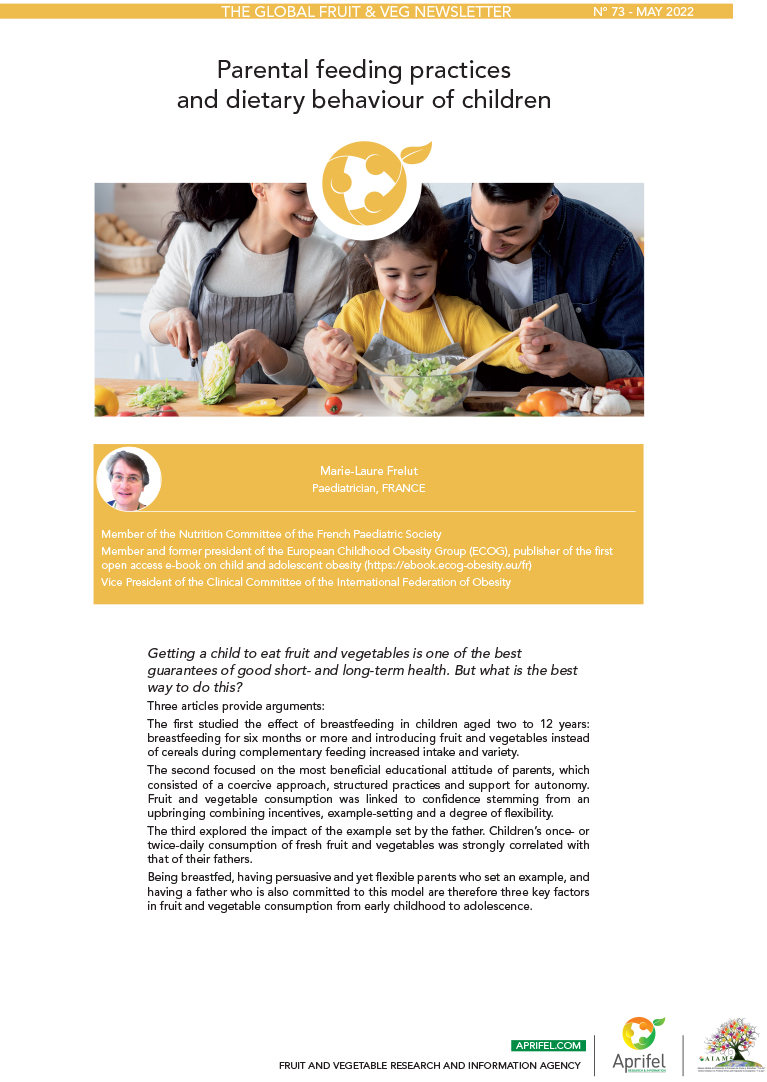Fruit and vegetable consumption : positive association between fathers’ daily intake and children’s consumption patterns

A large scientific consensus is established about the role of an adequate daily intake of fruit and vegetables in preventing major health implications such as cardiovascular disease, cancer, premature mortality, and diabetes (Li, 2014). However, European children are not meeting the recommended fruit and vegetable intake (at least 400 g/day) (WHO, 2004). The development of children’s food preferences is multifactorial, involving the complex interplay between genetics and environmental factors, including the home environment (Scaglioni, 2018). Parental influence has been identified as a key determinant of children’s food choice and consumption patterns via food availability at home, role modelling, family rules, and their own dietary practices and beliefs (Scaglioni, 2011). Convincing evidence from cross‐sectional studies has shown that, in families where parents consumed fruit and vegetables regularly, children also had an increased intake of healthy foods (Draxten, 2014; Jones, 2010; Rodenburg, 2012). Yet, research has focused only on the relationship between mothers’ and children’s eating habits, while little is known about fathers as potential agents.
Therefore, the present study aimed to explore in six European countries fruit and vegetable intake in children and the relationship between fathers’ and children’s fruit and vegetable intake, considering fathers’ education level and family income insecurity.
European children have low fruit and vegetable intake, especially in Southern European countries
Fruit and vegetable intake among all children was low. Only 45.6% and 37.7% consumed respectively, fresh fruit and vegetables 1-2 times per day.
When compared by country, differences were observed. Children’s fresh fruit intake of 1-2 times/day ranged from 61.1% in Belgium to 34% in Hungary, while vegetable intake ranged from 61.6% in Belgium to 20.1% in Greece. Overall, results indicated that a low fruit and vegetables intake was mainly observed in children from Southern European countries (Greece, Spain and Hungary).
Regarding fathers, only 65.9% consumed fruit and vegetable daily. Belgian fathers were more likely to consume fruit and vegetables daily (79.8%) while Hungarian had the lowest percentage (43.8%).
Children with fathers consuming fruit and vegetables daily were more likely to consume fresh fruit and vegetables
Significant positive associations were observed between fathers’ daily fruit and vegetables intake and children frequency of intake. In fact, when fathers consumed daily fruit and vegetable, children were 2.75 times and 2.55 times more likely to consume, respectively, fresh fruit and vegetables 1–2 times per day.
After adjusting for paternal educational level and family income insecurity, associations remained significant for fresh fruit and vegetables. However, disparities were found across countries, in Greece mainly where the positive association became nonsignificant after adjustment. This finding highlights that fathers’ educational level and income insecurity might be important factors worth considering for fruit and vegetable intake in Greece.
- The present study showed that children with fathers consuming FV daily were more likely to consume fresh fruit and vegetables 1–2 times per day.
- Future population‐based strategies promoting fruit and vegetable intake should be implemented not only in mothers, but also in fathers.
- A special attention should be given by policy makers to families dwelling in Southern European regions.
Based on : Papamichael et al. Fathers’ daily intake of fruit and vegetables is positively associated with children’s fruit and vegetable consumption patterns in Europe: The Feel4Diabetes Study J Hum Nutr Diet. 2021;1–13.

